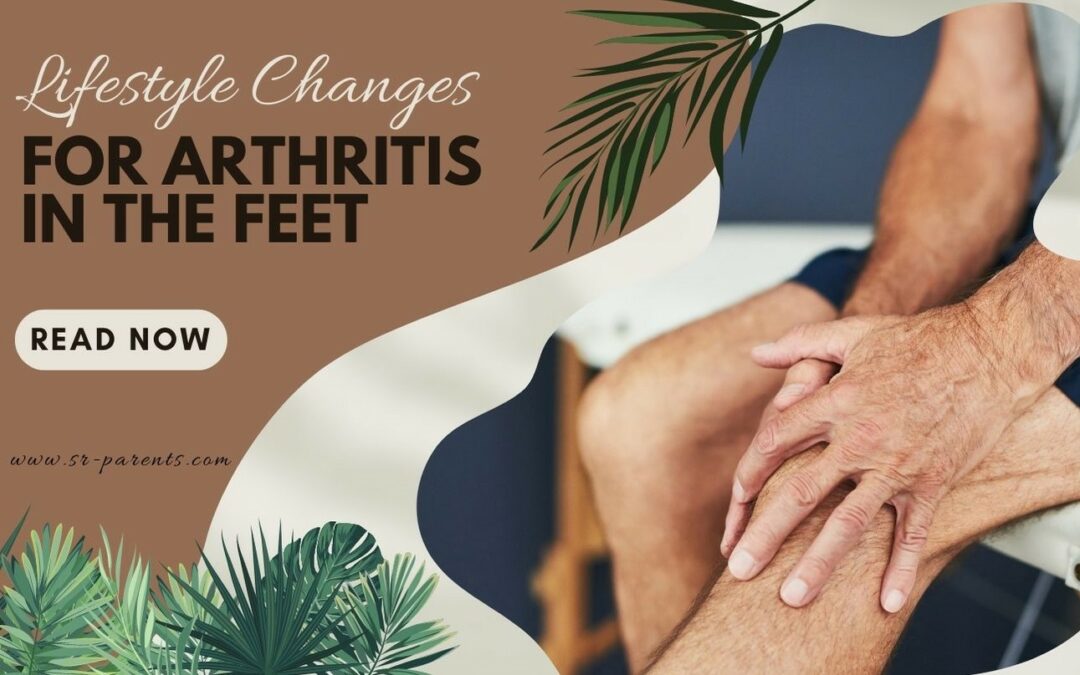Contents
Lifestyle Changes for Arthritis in the Feet

Lifestyle has always been the way a person lives their life. For me, though, it all boils down to the choices that they make every day! Now those choices get affected by many factors, especially if they have illnesses. In this article, I’ll do my best to give you my take on lifestyle changes for people with Arthritis. I’ll also give out important points to remember when making the changes.
What is Arthritis?
Arthritis is a prevalent condition that affects many people, young and old, worldwide. It is generally inflammation or swelling of the joints in your body. The best way to describe it would be pain in the knees or feet. This stiffness or pain usually pops up at age 40 and above. Though nowadays, that is not the case. People tell me that they’re taking medication for arthritis in their mid-30s.
Recent and Common Lifestyle
Now I’m not talking about everybody when I say that current lifestyles have been very bad. People often underestimate how much a burger or even a tiny cheesecake can hurt your body. Coupled with the lack or refusal to exercise, it will do a number on anyone’s body. That’s why it’s unsurprising that people are getting things that only older people should. Though recently, most of the complaints I have been hearing are arthritis. Some are saying that their elbows or wrists hurt more. But most will almost always say that their knees and feet hurt more often.
Arthritis in the Feet
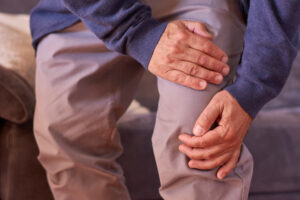
People often get arthritis in their feet, making life very difficult. This is because it makes even walking challenging because of the persistent pain! This applies to both the young and old. But for the latter, it’s even more of a nightmare to live with! The good news is that you can make several lifestyle changes to manage, lessen, or eliminate the pain or difficulties! The lifestyle changes I will give will focus more on older people since they have it worst. Just remember that doing and sticking to the changes is essential!
Common Types of Arthritis in the Feet

There are three common types of arthritis in the feet. These are the generally diagnosed ones. I’m giving these out to give a little bit more information. Though I would still recommend, you get an actual physician’s diagnosis.
Osteoarthritis
This is the “wear-and-tear” form of arthritis and gets worse over time. The worse thing about this form of arthritis is the fact that pain isn’t a reliable tell! The reason is that some people may have it bad and not even feel any pain. Generally, though, people with them will feel pain and stiffness. This especially happens if they stay still for a while. Some also experience swelling or tenderness in their ankles.
Rheumatoid Arthritis
Now this is the “autoimmune disease” arthritis and is less common. This means that it’s your immune system that causes the arthritis. Your immune system sees your healthy tissues are bad and attacks them. Because of the attack, swelling will almost always happen. Of course, pain and stiff joints will also follow. The worst thing about this form is that it can sometimes act up, and doctors call it “flares.”
Post-traumatic Arthritis
This form of arthritis happens from any trauma or injury. These can range from a bad fall and landing to even unfortunate accidents. The symptoms people get vary in type and time they get it. Some people immediately notice symptoms after a few weeks or months from injury. Others will feel it after years have gone by. The pain, swelling, or stiffness may only last a few weeks to a few months.
Lifestyle Changes for Arthritis
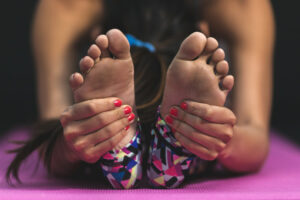
Now how can we prevent or help deal with arthritis in the feet? As I said earlier, the best way to do it is through lifestyle changes. The changes I’ve prepared are relatively easy to do and maintain.
1. The Need to Maintain a Healthy Weight
Let’s kick things off with the most effective lifestyle change for me. The reason why this is the most effective is that weight can contribute to arthritis! I mean, think about it for a sec. The amount of strain that your joints experience every day is always based on your weight. Let me be clear: I’m not saying you have to be skinny. I’m saying that you need to shed the extra pounds. The main goal is to avoid or lessen the unnecessary load on the feet.
Could You Tell Me How to Do It?
Maintaining a healthy weight comes easy. A combination of a balanced diet and regular exercise will always work. Eating less or avoiding unhealthy foods can do wonders for everyone’s health. Start with low-impact exercises. What’s important is that you get your blood pumping. Not too much, though, and you don’t have to overexert as well. Seniors can even get their daily dose of exercise with their everyday walk!
2. The Need to Choose Proper Footwear
Wearing appropriate footwear is essential for individuals with arthritis in the feet. Ill-fitting shoes can make things worse! Doing so already causes pain and discomfort. Wearing the proper footwear can provide support and reduce stress on the joints. Here are some tips for selecting suitable shoes:
A) Go for a Roomy Toe Box
Shoes with a broader toe box allow ample space for the toes. This may seem like a little but trust me, it works! This prevents crowding and reduces pain associated with arthritis on your toes.
B) Look for Good Arch Support
Arch support is essential for people with arthritis. It helps distribute weight evenly and reduces strain on the feet! Custom orthotics or orthopedics can help provide proper support and cushioning. Of course, even ordinary shoe inserts can do wonders by giving good arch support!
C) Choose Shoes With Low Heels
High heels put excessive pressure on the forefoot, making arthritis symptoms worse! Get shoes with a low heel or no heel to maintain stability and reduce discomfort. Of course, people will find it easier to balance and walk around with low to no heels.
D) Consider Cushioning and Shock Absorption
Shoes with adequate cushioning and shock absorption are very effective! It can help lessen the impact on the joints while walking or running. Please be sure to look for shoes with features like gel inserts or air-cushioned soles. Of course, you can also go for custom orthotics or orthopedics.
E) Avoid Narrow or Pointy-Toed Shoes
This tip is just a follow-up to my first one. Narrow or pointy-toed shoes can cause compression and discomfort on any foot. Choose shoes with a wider toe box to accommodate the foot’s shape. Pointy-toed shoes may look good, but it can’t beat the comfort you’ll experience by not getting them.
3. The Need to Engage in Gentle Exercises
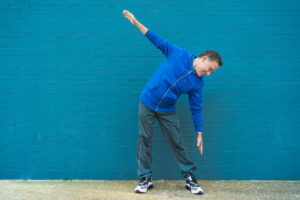
Regular exercise is essential for managing arthritis symptoms in the feet. Although it may seem counterintuitive to move when experiencing pain. But engaging in gentle exercises can improve arthritis symptoms! It helps with joint flexibility, reduces stiffness, and even strengthens the muscles. Particularly the ones surrounding the affected joints. Here are some suitable exercises for people with arthritis in the feet:
A) Range-of-Motion Exercises
These exercises involve moving the joints through their full range of motion. Doing these types of activities aims to maintain flexibility. Ankle circles, toe curls, and heel-to-toe rocking are some specific examples. Of course, you should only do these exercises mildly since too much may be harmful.
B) Strengthening Exercises
Strengthening the muscles around the affected joints can provide added support and stability. Exercises such as toe raises, heel lifts, and resistance band exercises can help. These exercises strengthen the foot and ankle muscles. They are also easy to do since even your elderly loved ones can do them!
C) Low-Impact Aerobic Exercises
Activities like swimming, water aerobics, and stationary cycling are excellent exercises. This is especially true for people with foot arthritis. They help with dealing with and lessening stress on the joints. They also provide a lot of cardiovascular benefits to the heart!
D) Yoga and Tai Chi
These popular mind and body practices combine gentle movements, stretching, and deep breathing. They can improve balance and flexibility. Doing so will help manage arthritis symptoms. It can even deal with pain, stiffness, or even flare-ups.
4. You Have to Take Regular Breaks
If you have a job requiring long hours standing or sitting, taking regular breaks is essential. Prolonged periods of immobility or staying still can cause stiffness and increased pain. By taking frequent breaks, you allow your joints and feet to rest and re-energize. Breaks can be in the form of you sitting down, walking around for a bit, and even stretching! What’s important is you give time for your feet to be free from pressure. Even putting your legs up can help a lot.
5. The Need to Do Stretches

Stretching before and after exercise can help improve flexibility and reduce joint pain. I’ve been saying this since earlier since this is one of the best ways to deal with arthritis as well! Doing stretches will serve to lubricate those painful or stiff joints.
Bonus Tip!
Breathing is essential when stretching! I’m not talking about the way you’re breathing now, though. I’m talking about diaphragmatic breathing. It means you breathe from your diaphragm and core muscles. You can quickly feel it slightly over your navel and below the ribs.
6. You Can Also Take Supplements
Now when you search for or even ask people, they will give you complicated names of supplements. I’m not discrediting or even saying that they aren’t effective. Studies and people researching arthritis can attest to their effectiveness. But, for me, natural supplements will always be the best! Supplements, such as fish oil, may help reduce ankle arthritis symptoms. It doesn’t even have to be fish oil concentrate. You can also get supplements from eating particular foods. Doing so will also provide some pain relief. Flax and chia seeds also help and do wonders for arthritis in the feet!
Bonus Tip!
Like in all things, you need to have moderation when taking supplements. They are in no way considered cures for arthritis. At most, they help improve symptoms and even your body. But getting more of it into your system is not necessary nor a good thing! Too many supplements may mess up some of your body’s chemistry. Though, of course, most of the time, they will get wasted. Any excess vitamins and minerals will get flushed out. But, some can build up and result in further harmful complications!
7. Using Warm or Cold Compress
Using a warming pad or cold compress for a few minutes can do wonders! It can easily loosen a stiff ankle joint, making movements easier. Of course, it depends on the situation which one to use and for how long. Icing the ankle joint 15 or 20 minutes after activity can decrease swelling. It will also definitely provide some immediate pain relief. It would be best if you remembered that heating or icing a joint may improve symptoms for a bit. It does not affect the actual cause of ankle pain and will not improve long-term joint function.
8. Visit and Consultations Needed
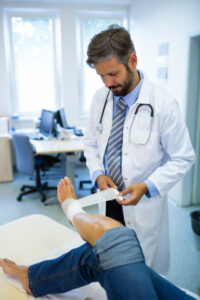
Please make sure to have frequent visits and consultations with physicians. The reason for that is because, as I said before, arthritis gets worse over time. Even with the lifestyle change, it’s not guaranteed that other factors may play in and make things worse. Getting a professional to take a look at your problems is always a good thing. They can even recommend other things to help with your foot’s pain or stiffness. Plus, knowing more about your body will always be a good thing.
Lifestyle Changes and Consistency

Living with arthritis in the feet can be challenging. But by making lifestyle changes, people can deal with pain and improve mobility. They can even enhance their quality of life. Again, consult with your physicians as well and regularly! Nothing will ever beat personalized advice and recommendations! By doing these lifestyle changes, I hope you or your elderly loved one can improve not just with the pain and stiffness but with your entire life. Making these changes will also help in giving you control over arthritis! Finally, you need to remember that consistency is the key! It would be best to keep doing these lifestyle changes without taking breaks to get the best results. Have patience, perseverance, and a positive attitude when dealing with arthritis!
Walking Hand in Hand: Empowering Lifestyle Changes for Arthritis in the Feet
Embracing lifestyle changes can greatly alleviate the challenges posed by arthritis in the feet, promoting improved comfort and mobility for older adults under your care. By prioritizing a holistic approach, such as maintaining a healthy weight, engaging in regular low-impact exercise, and wearing appropriate footwear, you can help manage the symptoms of arthritis effectively. Additionally, assisting with the modification of the living environment to reduce potential hazards and promoting stress reduction techniques can further enhance the well-being of individuals facing this condition. Remember, small adjustments in daily routines and providing emotional support can go a long way in empowering older adults to lead fulfilling lives despite arthritis in their feet. Your compassionate guidance will be instrumental in facilitating these essential lifestyle changes, enabling your loved ones or those in your care to live life to the fullest extent possible.
Watch YouTube Videos
Here are some YouTube videos I recommend watching! They are very informative and highly entertaining. They can give more information on arthritis in the feet and how to deal with it!
Video Credit: @WebMD
Video Credit: @arthritisadventure
Frequently Asked Questions:
How long do I have to keep doing these lifestyle changes?
For as long as possible. You will only see the best effects after doing these changes for some time. Of course, if your physician recommends otherwise, then follow what they say. Though it’s unlikely that they’ll have you stop living healthily.
How often do I have to do some of the changes?
It depends actually. For diet changes, you have to be consistent and avoid even having cheat days. For exercise and others, do so in moderation since again, too much can make things worse.
Will supplements really help out?
Yes. My answer comes from experience. I’ve taken natural supplements and have had testimonies from others as well. They work but then again there will always be cases where they won’t do much. Studies are being done on them and some are seeing positive results while others with none. Also, always consult your physician before taking in anything other than food.
Join a Warm and Caring Community for Senior Care!
If you want to join a community centered on helping elderly loved ones, then look no further! Our other social media platforms is filled with great insights, amazing discussions, and witty banter too. Aside from that, you’ll be able to gain knowledge wherever you are also. Still not convinced? Well, in our other social media platforms, we also have amazing camaraderie with like-minded individuals that will provide you with a safe haven.
No need to feel shy or embarrassed, all opinions are valid opinions here.
Facebook: https://www.facebook.com/sr.parents
Instagram: https://www.instagram.com/seniorparents/
Pinterest: https://www.pinterest.com/seniorparents/
Twitter: https://twitter.com/senior_parents

